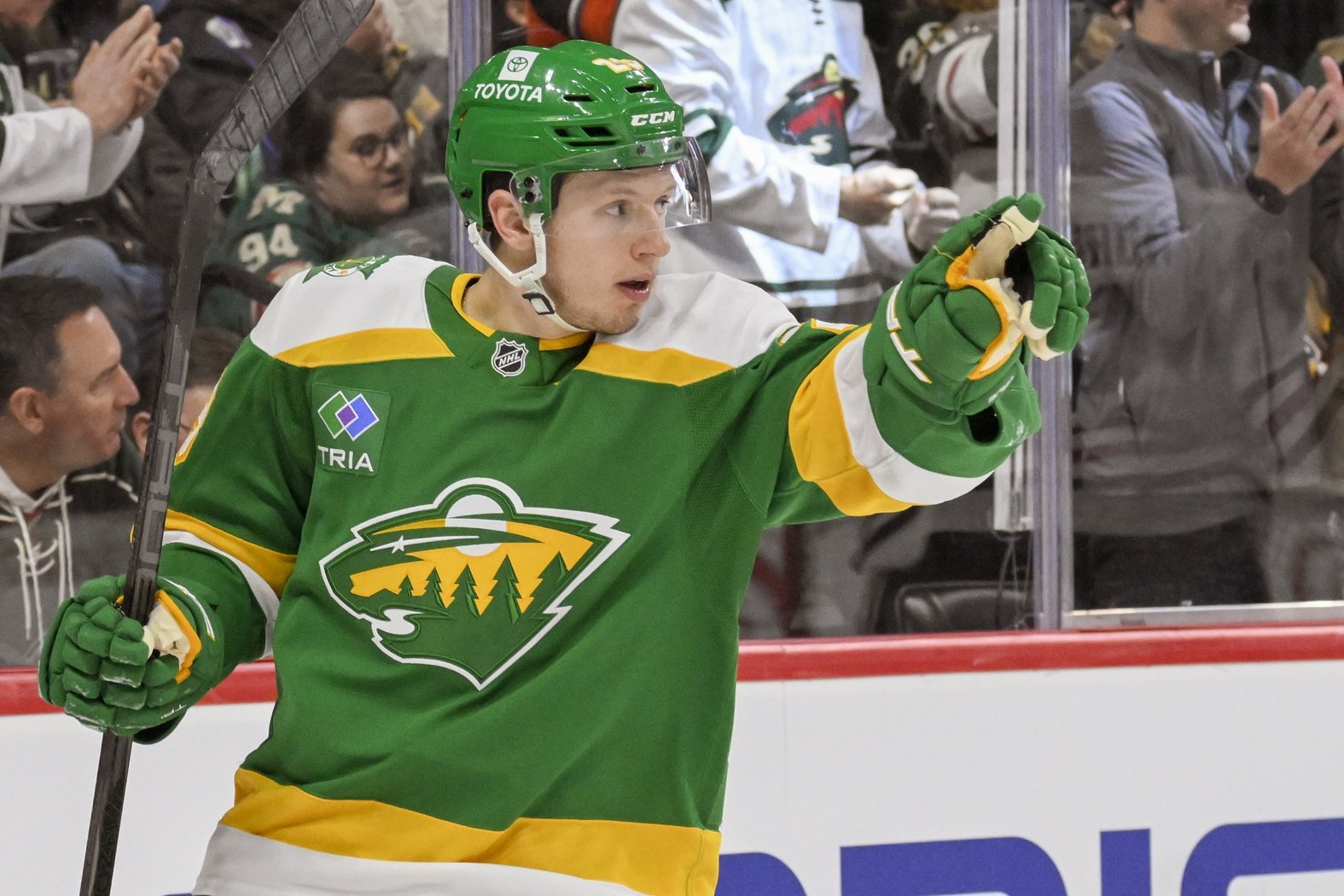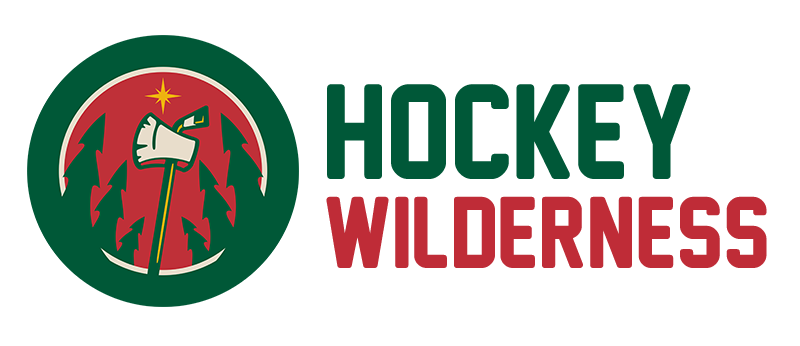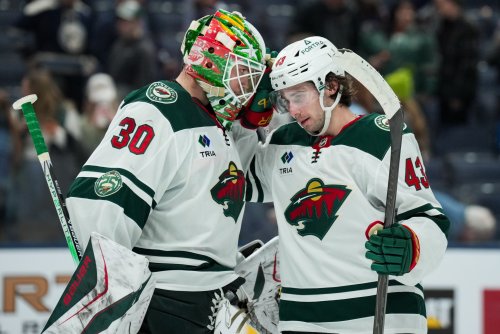
The 2025-26 season is about six weeks away, which means that Year 3 of Bill Guerin's five-year plan is about to get underway. The Minnesota Wild undoubtedly were hoping to enter this phase with their freed-up cap space spent on some big-name reinforcements -- no such luck.
Instead, the Wild are wrapping up their unfinished business as we enter the home stretch of the offseason. Kirill Kaprizov's incoming mega-extension is the big thing on the docket. Still, Guerin settled another negotiation last week, inking young center Marco Rossi to a three-year deal carrying a $5 million AAV.
Last week, we noted a curiosity in these extension talks. The market had been swinging towards giving young players like (and in many cases, less productive than) Rossi seemingly big paydays that would become modest as the salary cap skyrockets. Why fight so hard to keep the cap hit at $5 million when $7 million could have sewn him up for four extra seasons?
Reading back his talks with the media from July, it appears he already gave us the reason. "We have a structure in our pay that we have him slotted in at a certain level and that's just the way we're doing our business," the GM said as free agency opened.
Guerin's viewpoint was that term wasn't the priority for Minnesota, as it was for teams that inked up-and-coming players to long-term deals; it was the dollars.
So why was keeping the money down so important? When viewed through the lens of Guerin's plan, the tough negotiations and lack of willingness to go long-term become more understandable. It might be a coincidence that Rossi's deal starts in Year 3 and ends following Year 5 -- RFA extensions typically either buy UFA years, which the Wild didn't do with Rossi, or they walk them to within a year or two of free agency.
However, driving down Rossi's price to the exact endpoint of Guerin's five-year plan is also very helpful to his timeline. If it's a coincidence, it's a happy one.
The Wild will enter the season with a full roster and around $4.4 million in cap space, the most this team has had to play with in-season in a long time. That leaves them free to make a play the next time someone like Mikko Rantanen, Matthew Tkachuk, or Jack Eichel becomes available. As long as that move is made near the trade deadline, where pro-rated cap hits make taking on salary easier to do, the Wild are in a good spot to add whoever might be on the block.
There would have been benefits to locking in Rossi long-term, but to be fair, a $5 million commitment instead of $7 million does help enormously with their shorter-term flexibility. It will undoubtedly help them in the summer of 2026 or 2027, should Minnesota go big-game hunting then.
Looking at the 2026-27 season, the Wild have about $64.4 million committed against a $104 million cap ceiling. That's almost $40 million!... and it's also misleading. That cap space is going to get snapped up relatively quickly. Kaprizov's mega-extension might take up $14 or $15 million of that pie. Evolving-Hockey's contract projections predict a five-year deal carrying a cap hit nearing $7.5 million for Filip Gustavsson, unless Minnesota wants to roll the dice on Jesper Wallstedt.
Let's aim high with Kaprizov's deal ($15 million) and assume that Guerin sweet-talks Gustavsson down to $7 million. Suddenly, we're talking about $18 million of cap space.
That's still a lot! But again, it goes quickly. Presumably, the Wild will need to replace (or re-sign) Mats Zuccarello, Vladimir Tarasenko, and Marcus Johansson at forward, then Zach Bogosian at defense. Even on $1 million/entry-level deals, that's three players and $3 million gone.
They'll also presumably give a raise to pending RFA David Jiříček, who the Wild hope will be in a position to command a few million. Say Jiříček gets three years, $3 million AAV. Now, Minnesota's got at least $6 million of that $18 million off the board.
In doing this, we saved a Superstar Slot for whichever beautiful, talented so-and-so decides to grace the Wild with their presence. Whoever it is, our quick-and-dirty cap management predicts there'd be about $12 million at Minnesota's disposal to throw at them. That leaves just enough room for someone like, say, Artemi Panarin, who would be projected to make a bit over $11 million under a $104 million cap, per Evolving-Hockey.
Here's where the saved $2 million might be the most beneficial to Minnesota: Many keen observers have noted that Rossi's salary makes him easier to trade. But what if it also makes him easier to keep?
If Rossi's making $7 million instead of $5, it becomes much more difficult for the Wild to land a star player for 2026-27 without giving up salary somewhere else. $2 million is a relatively small amount against a $104 million cap. However, in practical terms, having $18 million to spend on five roster spots makes a significant difference compared to $16 million. Especially when $10 to $12 million of those dollars are earmarked for an impact player.
Many have assumed that trading Rossi is the path to landing that Rantanen-type player. But after this summer, which saw a shockingly tepid trade market for a 23-year-old, 60-point center, that might not be the case. Perhaps that changes if Rossi achieves another 20-point improvement next season and raises his value. But in that case, he's a point-per-game center making $5 million. Is that someone the Wild would really trade, even with the sometimes-bizarre relationship between player and club?
Probably not. It's just too nice of a bargain, even if Rossi stays at a 60-point level. And while $7 million for Rossi would be a similar home-run bargain, and for longer, it also makes it more difficult to slot in a big-time player into Minnesota's salary structure. Rossi at $5 million gives Minnesota a lot of options, and that includes the ability to easily keep him, even after star-plucking season begins.
It's still very possible that the Wild will come to regret not going long-term with Rossi and finding a way to move out other money whenever the need arises. Guerin still also has to execute on his five-year plan, not just bringing in a big-name player for its own sake, but one who can elevate his team's ceiling. However, seeing the $5 million next to Rossi's name on PuckPedia, we can begin to understand why securing a bargain on their young RFA center was their top priority.
Think you could write a story like this? Hockey Wilderness wants you to develop your voice, find an audience, and we'll pay you to do it. Just fill out this form.
-
 3
3
-
 1
1







Recommended Comments
Join the conversation
You can post now and register later. If you have an account, sign in now to post with your account.
Note: Your post will require moderator approval before it will be visible.